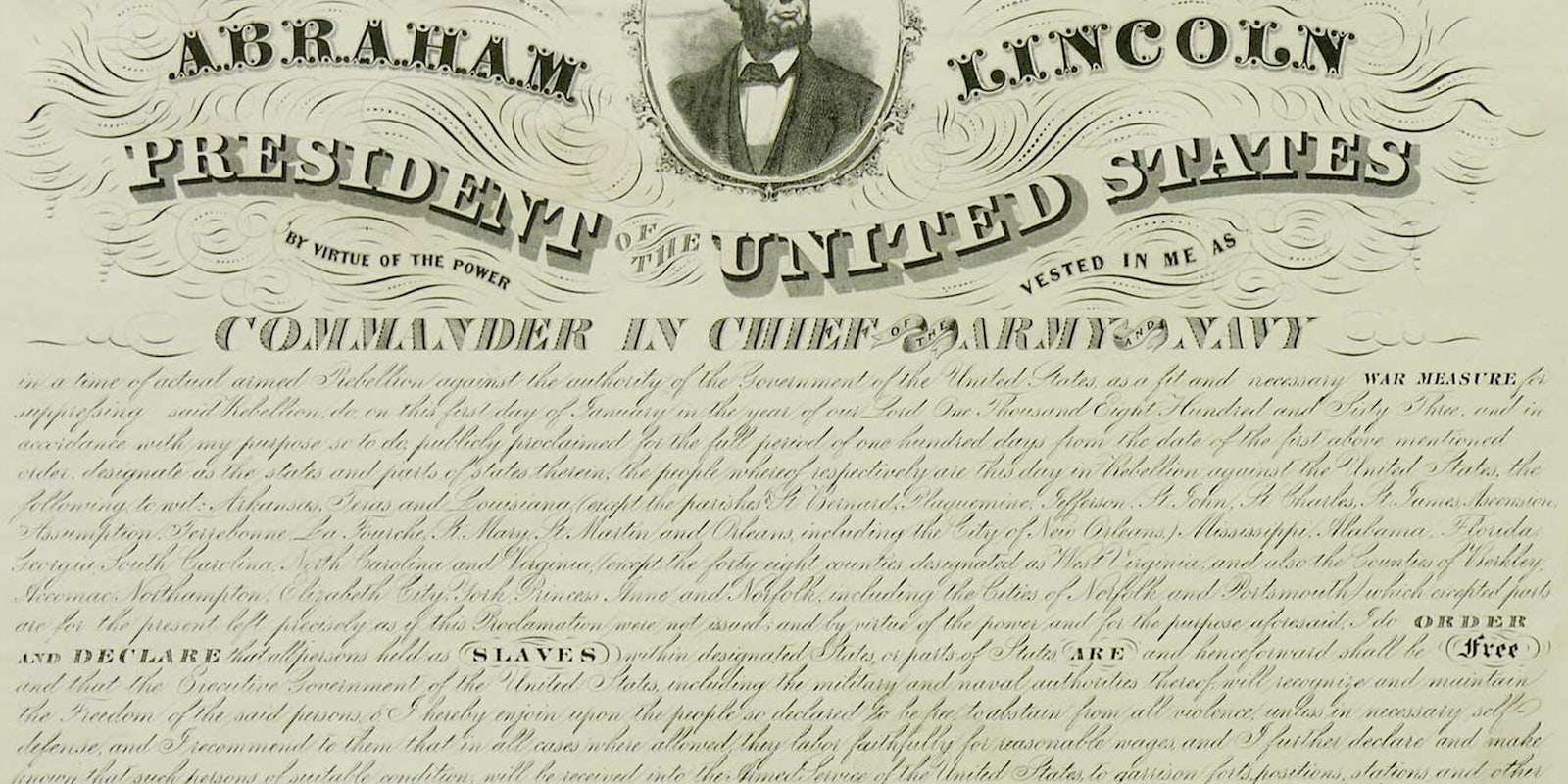Jan. 1, 2016, marks the 153th anniversary of Abraham Lincoln issuing the Emancipation Proclamation, which led to the freedom of the 3 million black slaves.
The Emancipation Proclamation, the final version of which Lincoln issued on Jan. 1, 1863, did not free black slaves on its own, but it was a key part of a freedom puzzle that included the grassroots abolitionist movement, the Underground Railroad, the Civil War, and the 13th Amendment to the U.S. Constitution, all of which contributed to their emancipation.
Here are eight facts everyone should know about the Emancipation Proclamation and abolitionism.
1) The end of slavery in the U.S. began decades before the Civil War.
The rise of the abolitionist movement started in the 1820s and became prevalent in northern churches and politics in the 1830s. Abolitionism called for the emancipation of black slaves in the South. This led to conflict between the northern and southern states in the U.S. and, ultimately, the American Civil War.
2) Harriet Tubman was making a name for herself before the Emancipation Proclamation.
Before the Emancipation Proclamation, Harriet Tubman became known as the “conductor” of the Underground Railroad in the 1850s. She was born into slavery in 1822 and endured brutal beatings as a field hand in Maryland. She fled slavery in 1849, leaving behind her family. She returned 19 times to help her family, friends, and hundreds of other black slaves escape to the North through the Underground Railroad, despite a bounty on her head.
Tubman is regarded as the “Black Moses” and as one of many prevalent black abolitionists of the 1800s.
“You’ve gotten out of chattel slavery, the institution of slavery. You’ve escaped and yet you come back,” Annette Gordon-Reed, a historian and law professor, told History Channel. “You have the courage and the care about other people to come back into hell to try to get other people out of it. It’s just… it’s an amazing story.”
3) The Emancipation Proclamation changed the focus of the Civil War.
Originally, the war focused on restoring the Union and didn’t have an anti-slavery stance, despite the advocacy of abolitionists and radical Republicans.
The Emancipation Proclamation changed that.
In issuing the decree, Lincoln announced that all slaves in the South “are, and henceforward shall be free.” More than 200,000 African-Americans were also conscripted into the Union army. And the implication soon became that supporting the Confederacy was the same as supporting slavery.
4) Lincoln’s advisors didn’t show much support.
Lincoln proposed the Emancipation Proclamation in July 1862, but his advisors thought it was too radical, according to the Civil War Trust. The president decided to move forward cautiously. He waited for the Union to gain a win in the war with the Confederacy before revealing the proclamation.
After the bloody battle of Antietam in September 1862, Lincoln’s advisors backed the president’s plan. Lincoln issued the preliminary Emancipation Proclamation soon after.
5) Lincoln flexed his executive power—carefully.
Lincoln exercised his executive power with the Emancipation Proclamation as a necessary war measure to weaken southern states who used slaves to fight for the Confederacy.
The president weighed his decision to unilaterally end slavery heavily, going so far as to question the constitutionality of his actions. In 1864, he wrote: “I felt that measures, otherwise unconstitutional, might become lawful, by becoming indispensable to the preservation of the constitution, through the preservation of the nation.”
Ultimately, the Proclamation was seen as one of the great victories of the Office of the President of the United States.
6) The final Proclamation.
The early stages of the Emancipation Proclamation began in July 1862, after Lincoln asked his advisors to begin drafting the document.
Lincoln’s preliminary Emancipation Proclamation demanded southern states give up their rebellion by Jan. 1, 1863 or he would put the Emancipation Proclamation into effect. The final draft of the Emancipation Proclamation was issued on that day in 1863.
Around 180,000 African-Americans joined forces with the Union and another 18,000 served in the Navy.
7) Europe sat out the Civil War, by design.
France and Britain may be two of our closest allies now. But that was not always the case. Both countries considered an alliance with the Confederacy to grow their influence in the West, but the Emancipation Proclamation prevented foreign involvement in the war.
8) The rise of the 13th Amendment.
The Emancipation Proclamation was Lincoln’s executive order, but it was only a start. He later pushed for an anti-slavery amendment to the U.S. Constitution, ensuring that the decree would not be overturned by future presidents.
The 13th Amendment was passed on April 8, 1864, by the Senate and Jan. 31, 1865, by the House of Representatives. Slavery officially ended on Dec. 6, 1865, for good.
Photo via Maine.edu


